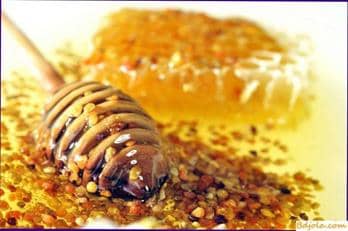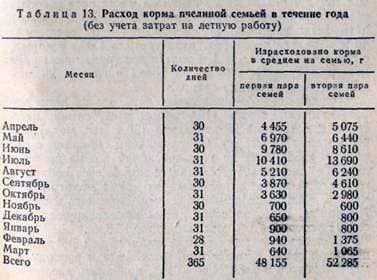
When organizing a beekeeping farm, it is necessary to be able to calculate how many bee colonies can be kept under given specific conditions or what honeybase should be created for the required number of bee colonies. In order to properly calculate, it is necessary to know the annual need of the bee family in the feed, which they spend on brood rearing, on waxing, on flight work and on maintaining the life of adult bees.
To determine the general need of the bee family in the honey base, the amount of honey taken in the form of a beekeeper’s surplus should be added to the obtained value of the feed during the calculation.
The general need of a bee family in the stern was first determined by SA Rozov (Institute of Beekeeping) by an experimental method. He placed hives with bees in greenhouses, where bees could not feed from the field, and, consequently, a decrease in the mass of the hives characterized the consumption of food by families. Experience has shown that a family with a mass in the spring of 1.5 kg, who built up 14-15 honeycombs on the wax, consumed 75-80 kg of honey and 15-20 kg of perga per year.
Later, the employee organized a determination of the total consumption of food by bee families, who worked under ordinary conditions in the apiary.
The 8 identical families of bees (4 pilot and 4 control) assigned to the experiment were put on scales and protected by a canopy from the effects of atmospheric precipitation. If the bees did not fly out during the day, the weighing of the hives gave the expense of feeding the families for all their work and needs in the hive. If the bees flew out during the day, they contributed a certain amount of food, which partially or completely covered their daily need for food.
In order to receive daily data on the consumption of food by the bee family, one of the following was done: from each pair of identical families, one was brought into a dark room (winter hut) at a temperature of 10-12 њ C, and the second was left in its place. The next day the hive was taken out of the premises and the second family was brought into the premises. Such a rearrangement of the hives was carried out throughout the active season. For each pair of families, the consumption of feed for the life of bees and the reproduction (for the family in a room where the bees could not fly) were determined and the feed was fed to the hive (by the family standing in the wild). In autumn, winter and non-flying weather, feed consumption was determined by direct weighing of all hives in summer places. The control families were standing all the time with the free flight of bees.
The verification of the described methodology showed that families flying in a day, grew as much brood and gave the same amount of wax as the control families, all the time standing in the wild. Only they made half the honey. The experimental families at the beginning of the main honey collection occupied 23-24 streets in hives-loungers and collected 35 kg of honey.
The summary of the amount of food consumed during the year is shown in Table 13.

The largest amount of bee was consumed in June and July, when the families grew the maximum number of brood. As a whole, for a year the families spent 48-52 kg of forage from the whole mass, introduced into the hive.
This amount does not include the part of the food that the bees collected from the flowers, but spent in the process of flying, not beating to the hive. Below are the calculations of the expended feed of the bee for flight work, larval feeding and wax release.
Feed consumption for flight work. By observing the tagged bees, I first determined that on average the flight of one bee lasts 51-53 minutes in May, 50-59 minutes in June, 41-52 in July, and 63-82 minutes in the longest flights in August. Further, throughout the summer, he periodically counted the number of bees flying out of the hive for 15 minutes every hour. Based on these data, he calculated the number of flights of bees per hour and per day at different intensities of honey collection. Defined the number of days non-flying, as well as with a strong, medium and weak summer bees. The data obtained allowed the author to calculate the number of bee flights during each month, and then the entire spring-summer season.
The feed consumption for flight work was calculated as follows. The bees made fly at the windows of the laboratory. They were given food (1 kg of sugar for 1 liter of water), weighed, let out for the flight and then re-weighed exactly after 10 minutes. The difference in the mass of the bees corresponded to the amount of food expended during the flight. Over 200 bees were weighed. On average, for 10 minutes of flight the bee without cargo spent 1.89 mg of feed, and with cargo – 2.18 mg. For one hour of flight without cargo the bee spent an average of 5.69 mg, and a bee with a weight of 28 mg – 6.55 mg (in terms of sugar).
These data made it possible to determine that for the flight work during the season (104 flying days), the bee family on average spent 26 kg of sugar (30.4 kg of honey). This is part of the food (nectar), which the bees collect from flowers, but do not deliver to the hive, spending it during the flight. In the same way, bees restore the mass of feces released during the flight due to the collected nectar. The feces released by the bees contain an average of 70% water. In total for a season bees compensate weight of crude excrement, making 13,3 kg.
Therefore, to determine the general need of the bee family in the honey base, it is necessary to add the feed to the hive (48-52 kg), add the feed consumption for flights (26 kg) and 13 kg, which compensate for the mass of excrement. All this will be about 90 kg. If we add to this mass a mass of honey taken by a beekeeper (35 kg), then it will amount to 125 kg, of which 20 kg falls on pollen. The total need for nectariferous plants in terms of honey will be about 105 kg for a full-fledged family of bees.
Feed consumption for feeding larvae. The first accurate experiments on the consumption of feed for feeding the larvae with the content of bee colonies in the conditions of the greenhouse were carried out by SA Rozov. First, he determined the feed consumption in four families that did not breed brood, and then gave the same brood for rearing to the same families and determined the additional consumption of fodder for brood rearing. Based on the data obtained, the author determined that for the feeding of 10,000 larvae (1 kg of bees), the bees consumed an additional 1.14 kg of honey and 894 kg of pollen.
Four families of bees participated in the experiment; of which 2 families grew brood, and 2 families (control) were brood-free. In just 9 days of experience, the honey bee was used in addition to 1086 larvae, 1286 g honey and 1089 g pollen.
Consumption of food for the allocation of wax. A lot of research has been done on this issue, which showed that the feed consumption depends to a large extent on the state of the bee family and the conditions in which it secrete the wax.
When burning 1 g of wax, 10.15 kcal is released, and 1 g of sugar is 4.18 kcal of heat. If we assume that bees produce wax from sugar, then 2.43 g of sugar should be used to form 1 g of wax. Provided that honey contains 20% water, the honey consumption per 1 kg of wax will be 3.0 kg. Thus, according to the amount of energy 1 kg of wax is equivalent to 3.0 kg of honey.
Experiments of the employees of the Institute of Apiculture showed that for the allocation of 1 kg of wax bees spent an additional 3.5 kg of honey. In the experience of the staff of the Bashkir experimental beekeeping station, an additional 3.6 kg of honey was consumed per 1 kg of wax. It can be assumed that 3 kg of bee honey consumes 1 kg of wax for production, and 0.5-0.6 kg of honey is spent on the process of this transformation. To isolate the wax, more pollen is needed, the amount of which is not yet determined.
In the same cases, when bees excrete wax simultaneously with the growth of larvae (during the honey harvest), the additional consumption of honey for the allocation of wax is significantly reduced due to a greater consumption of pollen.
Как закалить электрод. Мелипоны.
Feeding base of beekeeping